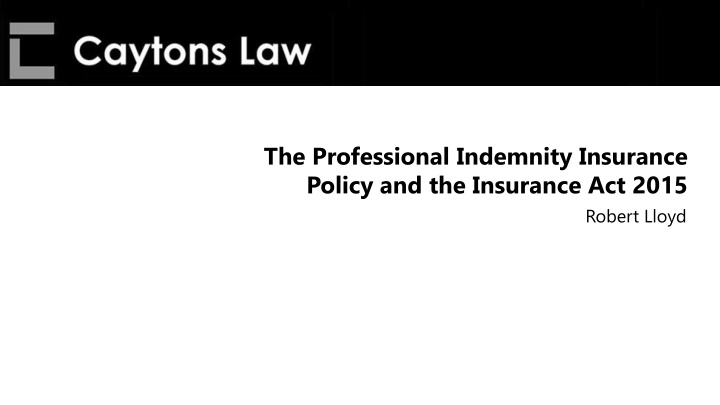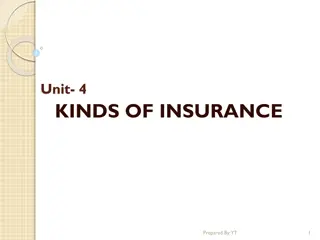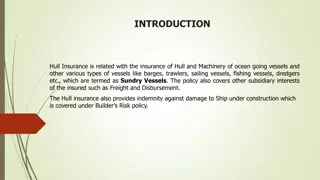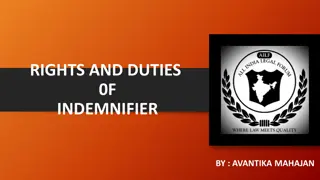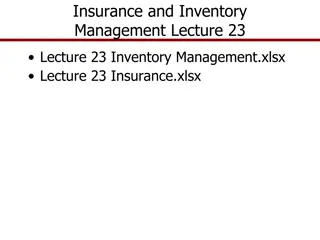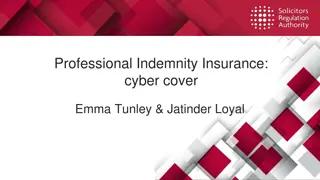The Professional Indemnity Insurance Policy Changes
Major changes in the Professional Indemnity Insurance Policy as per the Insurance Act of 2015 regarding duties, remedies, fraud, contracting, and third-party provisions. Understanding disclosure requirements, insurer responsibilities, and elimination of the basis clause.
Download Presentation

Please find below an Image/Link to download the presentation.
The content on the website is provided AS IS for your information and personal use only. It may not be sold, licensed, or shared on other websites without obtaining consent from the author.If you encounter any issues during the download, it is possible that the publisher has removed the file from their server.
You are allowed to download the files provided on this website for personal or commercial use, subject to the condition that they are used lawfully. All files are the property of their respective owners.
The content on the website is provided AS IS for your information and personal use only. It may not be sold, licensed, or shared on other websites without obtaining consent from the author.
E N D
Presentation Transcript
The Professional Indemnity Insurance Policy and the Insurance Act 2015 Robert Lloyd
Plus a change, plus c est la m me chose. The king is dead, long live the king!
The Major Changes A Duty of Fair Presentation (Section 3); Specified Remedies for Breach of Condition; Restrictions on Insurers Reliance on Warranties (Sections 9 and 10); Fraudulent Claims (Section 12 and 13); Contracting Out (Sections 15 18); and Third Party (Rights Against Insurers) Provisions (Section 19).
What the Insurance Act does not touch The Cover; The Limits and the Excess; The Exclusions; and The Premium.
The Insurers Big Guns The Basis Clause; Breach of Warranty; Misrepresentation and Non-Disclosure; Breach of the Duty of Utmost Good Faith; and Breach of Conditions Precedent to Liability. The Clive Boxer
The Balance of Power The Law; Innocent Non-Disclosure; Minimum Terms; and Commercial Reality. Signing of the first SRA Minimum Terms
Elimination of the Basis Clause Insurers, in consideration of payment of the Premium and in reliance upon the statements and information provided by the Policyholder prior to the date this Policy commences, which it is agreed forms the basis of and is incorporated into this Policy, agree to indemnify the Policyholder subject to the terms, exclusions, conditions, limitations, and endorsements of this Policy.
Duty of Fair Presentation disclosure of every material circumstance which the Insured knows or ought to know, or which gives the Insurer sufficient information to put a prudent Insurer on notice that it needs to make further enquiries for the purpose of revealing those material circumstances. Such disclosure is to be in a manner which would be reasonably clear and accessible to a prudent insurer and in which every material representation as a matter of fact is substantially correct, and every material representation as to a matter of expectation or belief is made in good faith. Section 3 Insurance Act (Paraphrased)
Qualifying Breaches of Duty of Fair Presentation Deliberate or reckless; or Not deliberate or reckless; and Insurer would not have entered into the contract or done so on different terms Then remedies in Schedule 1. Avoid and keep premium Avoid and return premium Apply different terms or reduce indemnity
Innocent Non-Disclosure No avoidance or rejection of indemnity on account of: Non-disclosure of facts; Misrepresentation of facts; Incorrect particulars; Late notification of claims and circumstances, Provided it was innocent and free of fraudulent conduct or intent. Conduct or breach or non-compliance with conditions giving rise to prejudice in the handling of settlement of a claim reduces indemnity to that payable in the absence of prejudice.
Breach of Conditions/Prejudice Defined Non-compliance with any condition that would tend to increase the risk of one or more of the following: Loss of a particular kind; Loss at a particular location; Loss at a particular time, And a loss occurs And the Insured cannot show that the breach or non-compliance could not have increased the risk of the loss which actually occurred in the circumstances in which it occurred. Section 11 (paraphrased)
Minimum Terms Insurer seeks reimbursement from a sole practitioner solicitor
Warranties The Insurer can only rely on a warranty to refuse liability for a loss occurring, or attributable something happening, prior to the breach of warranty being remedied (section 10(2)). The Insurer cannot rely on a breach of warranty if the warranty is no longer applicable to the circumstances of the policy, because of a change in circumstances, or if unlawful, or if the Insurer waives the breach (section 10(3)). The Insurer is liable for losses occurring, or attributable to something happening, before the breach or after the Insured is no longer in breach or if the risk is essentially the same as that originally contemplated (section 10(4) and 10(5)).
Fraudulent Claims Section 12 Insurance Act 2015 applied
Conclusion Key Date: 12th August 2016 7 weeks until solicitors renewal.
Coming Next Enterprise Act 2016 Claims must be paid within a reasonable time Insurance Act 2015 Amended.
The Professional Indemnity Insurance Policy and the Insurance Act 2015 Robert Lloyd
